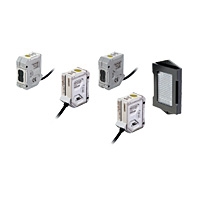Oil-resistant Photoelectric Sensors
E3ZR-C
 Photoelectric Sensors That Withstand Cutting Oil to Reduce Failures Caused by Ingress of Cutting Oil
Photoelectric Sensors That Withstand Cutting Oil to Reduce Failures Caused by Ingress of Cutting Oil
Sensors
|
Sensing method |
Through-beam |
Retro-reflective with |
Diffuse-reflective |
|
|
Model |
NPN output |
E3ZR-CT61[] (-M1TJ) |
E3ZR-CR61[] (-M1TJ) |
E3ZR-CD61[] (-M1TJ) |
|
PNP output |
E3ZR-CT81[] (-M1TJ) |
E3ZR-CR81[] (-M1TJ) |
E3ZR-CD81[] (-M1TJ) |
|
|
Sensing distance |
30 m |
2.5 m [100 mm] *1 |
0.5 m |
|
|
Standard sensing object |
Opaque: 12-mm dia. min. |
Opaque: 75-mm dia. min. |
--- |
|
|
Differential travel |
--- |
20% of sensing distance max. |
||
|
Directional angle |
Emitter, Receiver: 3° to 15° |
Sensor: 2° to 10° |
--- |
|
|
Light source (wavelength) |
Red LED (624 nm) |
Red LED (660 nm) |
Red LED (624 nm) |
|
|
Power supply voltage |
12 to 24 VDC ±10%, ripple (p-p) 10% max. |
|||
|
Current consumption |
35 mA max. |
30 mA max. |
||
|
Control output |
Output power supply voltage: 26.4 VDC max., Output current: 100 mA max. (Residual voltage: 2 V max.) |
|||
|
Protection circuits |
Reversed power supply polarity protection, output short-circuit protection, and reversed output polarity protection |
Reversed power supply polarity protection, output short-circuit protection, reversed output polarity protection, and mutual interference prevention function (with up to two Units) |
||
|
Response time |
Operate or reset: 1 ms max. |
|||
|
Sensitivity adjustment |
None |
|||
|
Ambient illumination (Receiver side) |
Incandescent lamp: 5,000 lx max., Sunlight: 10,000 lx max. |
|||
|
Ambient temperature range |
Operating: -25 to 55°C, Storage: -40 to 70°C (with no icing or condensation) |
|||
|
Ambient humidity range |
Operating: 35% to 85%, Storage: 35% to 95% (with no condensation) |
|||
|
Insulation resistance |
20 MΩ min. at 500 VDC |
|||
|
Dielectric strength |
1,000 VAC, 50/60 Hz for 1 min |
|||
|
Vibration resistance |
Destruction: 10 to 55 Hz, 1.5-mm double amplitude for 2 hours each in X, Y, and Z directions |
|||
|
Shock resistance |
Destruction: 1,000 m/s2 3 times each in X, Y, and Z directions |
|||
|
Degree of protection |
IP67 (IEC 60529) and IP67G *2 (JIS C 0920 Annex 1) |
|||
|
Connection method |
Pre-wired (standard length: 2 m), -M1TJ: Pre-wired connector (standard length: 0.3 m) |
|||
|
Indicators |
Operation indicator (orange) and stability indicator (green) (The Emitter has only a power indicator (green).) |
|||
|
Weight |
Pre-wired |
Approx. 200 g |
Approx. 100 g |
|
|
Pre-wired |
Approx. 140 g |
Approx. 70 g |
||
|
Housing material |
SUS316L |
|||
|
Cable material |
Fluororesin |
|||
|
Lens material |
Methacrylate resin (Oil-resistant high molecular weight type) |
|||
|
Indicator material |
Polyetherimide resin |
|||
|
Accessories |
Instruction manual |
|||
1. Values in parentheses indicate the minimum required distance between the Sensor and Reflector.
2. The IP67G is the degree of protection which is defined according to the JIS (Japanese Industrial Standards).
The IP67 indicates the same level of protection as defined by the IEC, and the G indicates that a device has resistance to oil.
3. The Oil-resistant Component Evaluation Standards are OMRON's own durability evaluation standards.
The Pre-wired Connector Model meets the degree of protection when it is correctly connected with an XS5[]R Oil-resistant Connector.
The degree of protection is not satisfied with the part where there is no XS5FR Oil-resistant Connector connected and cable wires are uncovered.
And as for the Pre-wired Models, the degree of protection is not satisfied with the part where cable wires are uncovered.
Accessories (Sold Separately)
Reflector
|
Name |
Oil-resistant Reflector |
|
Model |
E39-R1R |
|
Directional angle |
30° min. |
|
Ambient temperature range |
Operating: -25 to 55°C, Storage: -40 to 70°C (with no icing or condensation) |
|
Ambient humidity range |
Operating: 35% to 85%, Storage: 35% to 95% (with no condensation) |
|
Degree of protection |
IP67 (IEC 60529) and IP67G *1 (JIS C 0920 Annex 1) |
1. The IP67G is the degree of protection which is defined according to the JIS (Japanese Industrial Standards).
The IP67 indicates the same level of protection as defined by the IEC, and the G indicates that a device has resistance to oil.
2. The Oil-resistant Component Evaluation Standards are OMRON's own durability evaluation standards.




